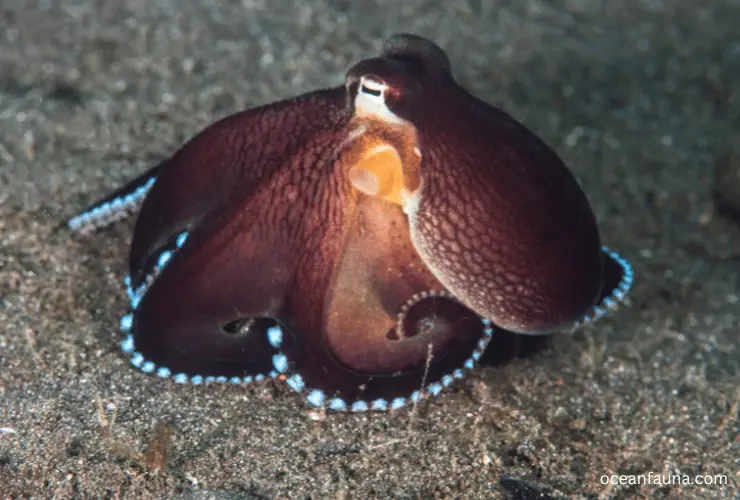The coconut octopus, also known as the “veined octopus” or Amphioctopus marginatus. It is a medium-sized cephalopod residing in the warm waters of the western Pacific Ocean. This clever creature likes to eat shrimp, crabs, and clams. It has a quirky personality, including walking on two legs and using tools like coconut shells and seashells to make a shelter.
The coconut octopus is a fascinating creature that has captured the attention of many researchers and nature enthusiasts. Its unique behaviors, such as bipedal walking and tool use, have made it a popular subject of study among scientists. Despite its quirky habits, the coconut octopus is a fierce predator in the ocean.
Curious about why the coconut octopus is so intelligent and can walk on two legs? Read our article to explore the amazing behavior, habitat, diets, locations, and adaptations of this unique cephalopod. Join us on a journey of discovery into the world of the coconut octopus!
About Coconut Octopus – A Quick Biology
Interested in the quick biology of the beautiful coconut octopus? Keep reading to discover more intriguing facts about this unique and intelligently veined octopus! (Source)
| Parameters | Details |
| Scientific name | Amphioctopus marginatus |
| Kingdom | Animalia |
| Family | Octopodidae |
| Genus | Amphioctopus |
| Phylum | Mollusca |
| Class | Cephalopoda |
| Order | Octopoda |
| Species | A. marginatus |
| Habitat | found on sandy bottoms in bays or lagoons |
| Life Span | 3 – 5 years |
| Diet | Invertebrates |
| Geography | Tropical waters of the western Pacific Ocean |
| Weight | 200 – 250 g |
| Length | 3 – 6 inches |
Coconut Octopus Encyclopedia: Top 10 Facts About It
In this Coconut Octopus Encyclopedia, we’ve compiled the top 10 most interesting facts about this quirky marine animal. So come along and uncover the amazing world of the coconut octopus. Hope you will enjoy reading these facts!
1. Appearance and description of a coconut octopus
Get ready to meet one of the most intriguing creatures of the sea—the coconut octopus! Typically measuring around 15 centimeters (6 inches) long, including its arms, this little cephalopod is usually around 8 centimeters (3 inches) long in the body.
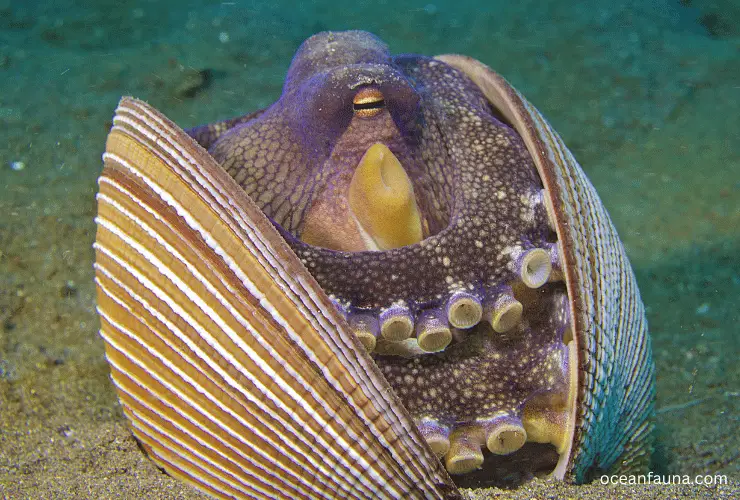
Sporting a distinctive color pattern, the coconut octopus features dark, vein-like lines that branch out over its body and a yellow siphon. Its arms are usually a darker color with contrasting white suckers. If you look closely, you may notice a light trapezoidal area just below its eye.
Its unique coloration is just one of the many things that make it special. And despite its small size, this cephalopod is a fierce predator in the ocean, using its intelligence and agility to hunt for shrimp, crabs, and clams.
2. Geographic Location
The Coconut Octopus is found mainly in the tropical waters of the western Pacific Ocean, from Indonesia to the Philippines, Papua New Guinea, and as far south as Vanuatu.
They have also been spotted in the Indian Ocean, from South Africa to Japan and down to Australia. They can be found in shallow coastal waters, on coral reefs, and even in intertidal zones.
According to research about the geographic distribution of coconut octopus:
“The Amphioctopus marginatus, commonly known as the Veined Octopus, is primarily found in the Indian Ocean. Its habitat ranges from South Africa to Japan and extends down to Australia. It shares its home with many other species that neither prey on nor are preyed upon, including the Portuguese man-of-war from the Cnidaria phylum and the Lunartail Puffer Fish from the Chordata phylum. The fascinating behavior of this octopus has been studied in detail in the coconut-filled waters of Vizhinjam Bay, which is situated in the Thiruvananthapuram District of Kerala, India.” (Source)
3. Behavior and Habitats
The coconut octopus has a unique habitat, preferring to reside in bays or lagoons with sandy bottoms. To avoid detection, it frequently buries itself in the sand, with only its eyes visible.
The clever cephalopod has also been observed displaying bipedal locomotion – a rare behavior only exhibited by one other octopus species, the Abdopus aculeatus.
Researchers from the University of California discovered this behavior in an area of Sulawesi, Indonesia, where the ocean floor was littered with coconut shells. The bipedal motion appears to imitate a floating coconut, allowing the octopus to blend in with its surroundings.
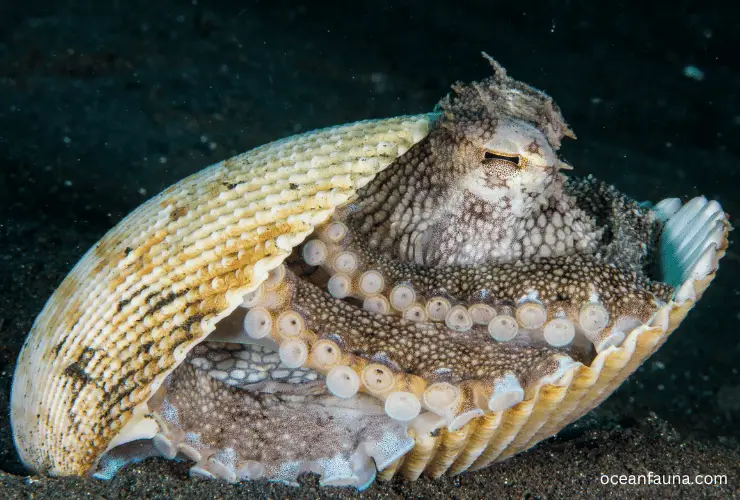
The coconut octopus has also been observed using tools for concealment and defense, according to researchers from the Melbourne Museum in Australia. In Bali and North Sulawesi, Indonesia, individuals were filmed collecting discarded coconut half-shells from the sea floor.
The clever creatures carried the shells up to 20 meters and arranged them around their bodies to create a spherical hiding place similar to a clam shell. This behavior is thought to protect the animal from predators such as eels and larger octopuses. Overall, the coconut octopus continues to surprise researchers with its clever and adaptive behaviors. (Source)
4. Diet of a coconut octopus
“The coconut octopus, like most other octopus species, feeds on invertebrates such as shrimp, crabs, clams, and sometimes small fish. They prefer to hunt at dawn and dusk, using their arms to grab their prey or their skirt to smother it.
“The coconut octopus has a venomous bite, and one bite can quickly paralyze its prey. It can also drill into hard shells like clams with its beak, inject venom, and suck the paralyzed animal out of the drill hole. It uses a hybrid style for catching prey.” (Source)
The coconut octopus has a few other tactics for hunting prey, such as burying itself in sand or mud and waiting for an unsuspecting meal to swim by. This method requires minimal energy but can yield a significant source of food. Additionally, the coconut shell that they frequently use can also be used to their advantage when hunting.
Also Read: How Many Stomachs Does an Octopus Have?
These veined octopuses are known to use their cryptic behavior to deceive their prey. Shrimp and crabs can easily fall into the trap of mistaking the octopus’s empty-looking coconut shelters as uninhabited, only to be captured and eaten by the clever octopus. The octopus’s crypsis is used not only as a means of defense but also to lure its prey.
5. Reproduction system
Octopuses are typically solitary and only come together during breeding seasons. The breeding patterns of these creatures are unpredictable, and they will breed when the opportunity arises.
Amphioctopus marginatus and other octopus species reproduce sexually through internal fertilization. During reproduction, males have a specialized tentacle that transports sperm.
To ensure a successful reproductive cycle, the female must lay her eggs in a safe location. Octopuses usually inhabit a den, which they use as a home and a safe place to protect their fertilized eggs.
After fertilization, the female generates egg clusters called festoons, which she attaches to rocks and other surfaces inside the den. The female then enters an incubation period.
In an ethological study of the Veined Octopus, researchers found that they attach egg clusters, known as festoons, to the inside of their portable-protective coconut shelters. One examined octopus was found to be carrying 22 festoons with a total of around 20,000 eggs.
During the brooding period or incubation, the female octopus becomes highly active and protective, removing anything that could harm her offspring until the eggs hatch. It’s worth noting that the female can starve and die during this period since she spends little time foraging for food.
After 16 days, the hatchlings resemble the general body shape of an adult octopus and are planktonic in nature, which explains their wide distribution. They can survive for a while before entering later developmental stages, allowing for dispersal through ocean currents. (Source)
6. The life cycle of a coconut octopus
Animalspot.net’s authors has brilliantly explained the life cycle and age span of a coconut octopus. Let’s see what they are saying about it:
“The offspring of coconut octopuses initially exist as plankton. Once hatched, they are often carried away by ocean currents and feed on copepods during their planktonic stage. After 1-2 years, they reach sexual maturity. These octopuses generally have a lifespan of 3-5 years.” (Source)
7. The intelligence of coconut octopus
Octopuses are among the most intelligent invertebrates, with highly developed brains containing roughly 500 million large neurons.
These creatures exhibit exceptional problem-solving abilities, as they can open doors and unscrew jar lids. However, when comparing all animals, dolphins are known to have higher cognitive abilities than octopuses. (Source)
Scientists have studied their ability to use tools, such as carrying and using coconut shells for protection and shelter, and their problem-solving skills, such as unscrewing jars to access food. They have also been studied for their reproductive behaviors, including brooding and caring for eggs.
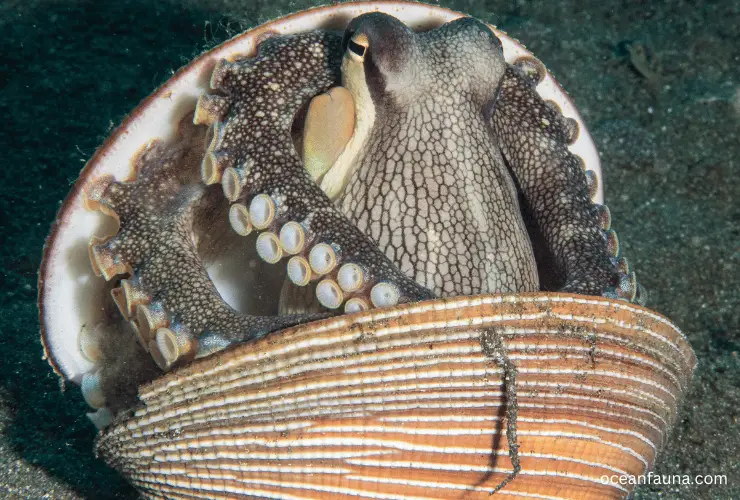
Studying the coconut octopus can provide insight into the evolution and behavior of cephalopods, which are a group of highly intelligent and adaptable animals.
Additionally, understanding their behaviors and interactions with their environment can help inform conservation efforts and management practices for coastal ecosystems.
8. Importance to Ecosystems and Research
Coconut octopuses play an important role in their ecosystems as both predators and prey. As predators, they help control the populations of small crustaceans and mollusks, and as prey, they serve as a food source for larger predators such as sharks and other marine mammals.
It is important to note that while octopuses, including the coconut octopus, are a traditional food source in many Asian cultures, their consumption has come under scrutiny due to sustainability concerns.
Overfishing and destructive fishing practices, such as bottom trawling, have led to declines in octopus populations.
Additionally, some species of octopuses are considered vulnerable or endangered. As a result, there is increasing pressure to adopt more sustainable and responsible fishing practices and to consider alternative protein sources.
It is important to be aware of the impact of our food choices on the environment and to make informed decisions about the food we consume.
9. Threats and Conservation Status
As with many species of cephalopods, the coconut octopus faces threats from human activities. The collection of these animals for the aquarium trade and food, and the destruction of their habitats through pollution, coastal development, and unsustainable fishing practices, pose significant risks to their survival.
Despite these threats, there are currently no conservation measures in place specifically for the coconut octopus.
However, their importance in marine ecosystems and their unique behaviors and intelligence make them excellent candidates for further conservation efforts.
It is important to raise awareness of the threats that coconut octopuses face and to promote responsible fishing practices and the protection of their habitats to ensure their survival for generations to come.
According to Animalspot.net researchers, “The conservation status of coconut octopus has not been evaluated by the IUCN.” (Source)
The IUCN (International Union for Conservation of Nature) is an organization that assesses the conservation status of various species, including animals and plants.
The conservation status is an indication of how vulnerable a species is to extinction based on factors such as habitat loss, pollution, and hunting.
The statement that the conservation status of coconut octopus has not been evaluated by the IUCN means that there is no formal assessment of the vulnerability of this species to extinction.
Therefore, it is unclear if the coconut octopus is threatened or not, and further research may be needed to determine its conservation status.
10. Coconut Octopus Interactions
Only those who have experienced diving with these intriguing little creatures can truly appreciate their remarkable nature. They display an exceptionally curious demeanor, which surpasses that of other octopus species. These octopuses have been observed to leap onto divers and examine their gear to determine whether anything may be beneficial to them.
Footage of the cephalopods in action often depicts them dragging divers’ cameras into their lairs, creating a tug-of-war situation. If presented with a shell, they will take it back to their lair, test it, and discard it if unsuitable.
Conversely, if they fancy it, they will keep it and frequently discard an older one in favor of the new one. While they appear content to interact with divers, one should not attempt to handle them. If they hop onto a diver, it is best to remain still until they become disinterested and let go.
Why Are They Called Coconut Octopuses?
“The name of the coconut octopus is derived from its habit of utilizing empty coconut shells as shelter on the muddy seafloor along the coast. The use of coconut shells as tools is a fascinating behavior that has drawn much attention from scientists and nature enthusiasts.”, states the Oceana organization. (Source)
The coconut octopus is easily distinguishable by its distinctive skirt or webbing, which extends significantly towards the tips of its arms, unlike most other octopuses. This unique feature gives the coconut octopus an almost parachute-like appearance.
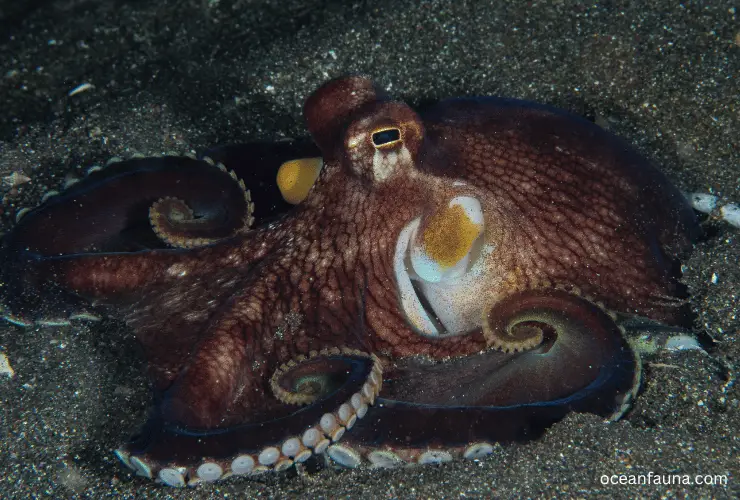
Although the coconut octopus is famous for its use of coconut shells as a tool for defense, it can also utilize clam shells, depending on their size.
However, this species is under threat from heavy fishing, which may cause habitat destruction or bycatch from fisheries targeting other species.
Also Read: How Do Octopus Poop?
In addition to their use as tools, the shells collected by the coconut octopus can also be utilized as a den or a protective fort.
Researchers in Indonesia observed this behavior and filmed the octopus gathering discarded coconut shells lying in the mud along the seafloor, carrying them up to 66 feet (20 meters), and then constructing them into a hiding place.
The octopus will continue searching for other shells while carrying one, testing several like a Colorful Hermit Crab.
The coconut octopus sometimes confuses plastic debris in the ocean for burrows. These cephalopods can also come across human-made objects in the sand or mud, where they search for shells to use for protection. Unfortunately, these animals may mistake trash for their homes, which highlights the negative impact of human activities on marine ecosystems.
Here, another question pops up in our minds. That is: why is it also commonly called a veined octopus? Its answer is pretty simple. The ‘Veined Octopus’ is so named due to the distinctive veins that can be observed all over its body.
How Does Coconut Octopus Move?
Marine biologists discovered that coconut octopuses could carry two half shells that are bigger than themselves. The octopuses sit on the shells and use two arms on either side to support them. They drag themselves across the seabed using the rest of their arms. This method of locomotion is called Stilt Walking.
Despite its unconventional appearance, the coconut octopus’ carrying technique allows it to secure itself inside the shells if necessary. While some predators may be able to break the shells, many lack the cognitive ability to do so. As the first invertebrate recorded to use tools, the coconut octopus is one of the few sea creatures known to exhibit tool use. (Source)
Do Coconut Octopuses Throw Coconuts?
No, coconut octopuses do not throw coconuts. A recent study has revealed that octopuses have the unique ability to use coconut-shell halves as portable protective shelters.
They are observed to be able to tip-toe with these shells suctioned to their undersides before reassembling the halves and disappearing inside. This behavior was first discovered by researchers in 1998 and has since been studied in more detail.
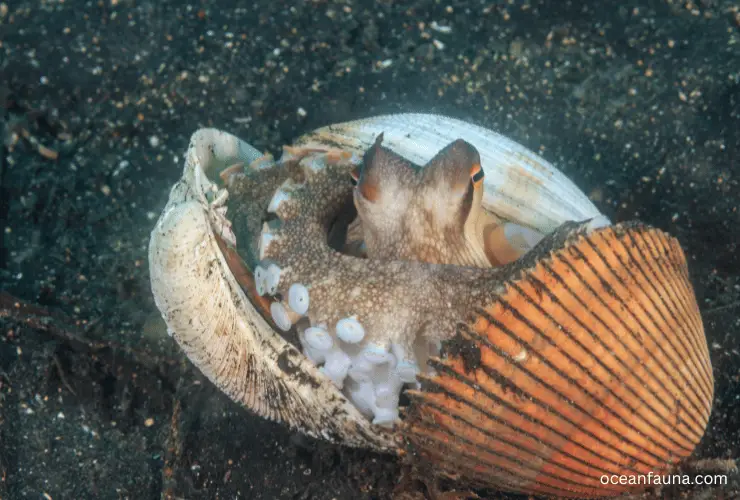
This behavior is thought to be used for both protection and deception purposes. This new finding sheds light on the complex and intelligent behavior of octopuses, which have been previously known for their problem-solving skills, as well as their unique anatomy and life cycle.
What Are the Predators of The Coconut Octopus?
Coconut octopuses have many predators, including viperfish, great white sharks, and larger octopuses. These predators prey upon the coconut octopuses for various reasons, such as food or territory.
- The viperfish is a deep-sea predator that feeds on a variety of prey, including the coconut octopus.
- Great white sharks are known to feed on a variety of marine animals, including octopuses.
- Larger octopuses are also natural predators of the coconut octopus, as they compete for resources and space in the marine environment.
These predators can have an impact on the population of coconut octopuses and are an important factor to consider when examining the ecology and conservation of these animals.
What Adaptations Does the Coconut Octopus Have?
Coconut octopuses have the following adaptations: (source)
- Coconut octopuses are capable of bipedal movements and slit walking, which enables them to carry their concealment tools like coconut or clam shells with the other six tentacles.
- The absence of an exoskeleton allows the octopuses to fit easily into the shells, roll themselves, and deceive predators, as they look like rolling coconuts.
- The chromatophore cells in their skin enable them to change their skin color, helping them to blend into their surroundings and providing them with camouflage.
- These octopuses have a sharp beak that enables them to chew crustaceans and fish.
Thus, the coconut octopus is a fascinating and unique creature with many extraordinary adaptations for survival.
Most Interesting Facts About Coconut Octopus: Special Features and Characteristics
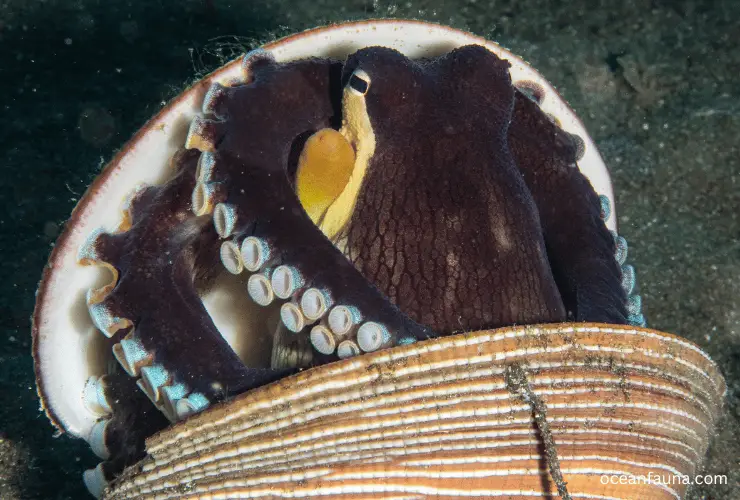
Let’s introduce the unique and fascinating coconut octopus, a species known for its special features and characteristics:
- The coconut octopus is thought to be among the two species of octopuses that can display bipedal locomotion – a unique ability to move using two limbs, similar to the way humans walk.
- Adult coconut octopuses usually die shortly after they reproduce.
- Female coconut octopuses lay around 100,000 eggs that measure about 3 mm in length.
- The embryos of coconut octopuses hatch as small as plankton and remain small for some time before reaching adulthood.
- Coconut octopuses have been observed to use and carry trash as their protective tool.
- Coconut octopus has a total of three hearts. Two of these hearts pump blood through each of the two gills, providing oxygenation. The third heart functions to pump blood throughout the entire body.
- Coconut octopuses possess a body-to-brain ratio similar to that of mammals and birds.
FAQs
What is a Coconut Octopus?
A Coconut Octopus (Amphioctopus marginatus) is a species of cephalopod that is native to the tropical waters of the western Pacific Ocean. It is known for its ability to use coconut shells or other objects as a protective shelter.
Is the coconut octopus poisonous
Yes, coconut octopus is poisonous. There is currently no evidence that suggests coconut octopuses are lethal to humans. However, like all octopuses, they do possess a beak and can bite if they feel threatened or provoked. It is important to exercise caution and respect when observing any wild animal, including the coconut octopus.
What is unique about the coconut octopus?
The coconut octopus is unique in several ways. It has a unique behavior of using coconut shells, clam shells, and other objects as portable shelters. In terms of their appearance, coconut octopuses have distinct coloration and patterns, with a beige or brown body covered in a network of black markings, and they have long, flexible arms that they use to navigate and capture prey.
How long does a coconut octopus live?
Compared to other smaller octopus species, coconut octopuses have a longer lifespan of about three to five years. While males have a significantly shorter lifespan, dying within just a few weeks or even days, females can live for several months or even years.
However, female coconut octopuses tend to die after the hatching of their eggs as they stop eating during the entire brooding period to protect and care for their young.
Conclusion
The coconut octopus is worth considering as a species with special features, such as bipedal locomotion and the use of trash as a protective tool. Its characteristics, such as a short lifespan, multiple hearts, and a body-to-brain ratio similar to mammals and birds, are also amazingly interesting.

